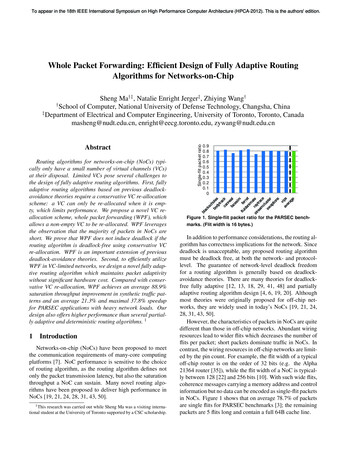
Transcription
To appear in the 18th IEEE International Symposium on High Performance Computer Architecture (HPCA-2012). This is the authors' edition.Whole Packet Forwarding: Efficient Design of Fully Adaptive RoutingAlgorithms for Networks-on-ChipSheng Ma†‡ , Natalie Enright Jerger‡ , Zhiying Wang†School of Computer, National University of Defense Technology, Changsha, China‡Department of Electrical and Computer Engineering, University of Toronto, Toronto, Canadamasheng@nudt.edu.cn, enright@eecg.toronto.edu, zywang@nudt.edu.cnAbstractRouting algorithms for networks-on-chip (NoCs) typically only have a small number of virtual channels (VCs)at their disposal. Limited VCs pose several challenges tothe design of fully adaptive routing algorithms. First, fullyadaptive routing algorithms based on previous deadlockavoidance theories require a conservative VC re-allocationscheme: a VC can only be re-allocated when it is empty, which limits performance. We propose a novel VC reallocation scheme, whole packet forwarding (WPF), whichallows a non-empty VC to be re-allocated. WPF leveragesthe observation that the majority of packets in NoCs areshort. We prove that WPF does not induce deadlock if therouting algorithm is deadlock-free using conservative VCre-allocation. WPF is an important extension of previousdeadlock-avoidance theories. Second, to efficiently utilizeWPF in VC-limited networks, we design a novel fully adaptive routing algorithm which maintains packet adaptivitywithout significant hardware cost. Compared with conservative VC re-allocation, WPF achieves an average 88.9%saturation throughput improvement in synthetic traffic patterns and an average 21.3% and maximal 37.8% speedupfor PARSEC applications with heavy network loads. Ourdesign also offers higher performance than several partially adaptive and deterministic routing algorithms. 11IntroductionNetworks-on-chip (NoCs) have been proposed to meetthe communication requirements of many-core computingplatforms [7]. NoC performance is sensitive to the choiceof routing algorithm, as the routing algorithm defines notonly the packet transmission latency, but also the saturationthroughput a NoC can sustain. Many novel routing algorithms have been proposed to deliver high performance inNoCs [19, 21, 24, 28, 31, 43, 50].1 This research was carried out while Sheng Ma was a visiting international student at the University of Toronto supported by a CSC scholarship.Single-flit packet ratio†0.90.80.70.60.50.40.30.20.10Figure 1. Single-flit packet ratio for the PARSEC benchmarks. (Flit width is 16 bytes.)In addition to performance considerations, the routing algorithm has correctness implications for the network. Sincedeadlock is unacceptable, any proposed routing algorithmmust be deadlock free, at both the network- and protocollevel. The guarantee of network-level deadlock freedomfor a routing algorithm is generally based on deadlockavoidance theories. There are many theories for deadlockfree fully adaptive [12, 13, 18, 29, 41, 48] and partiallyadaptive routing algorithm design [4, 6, 19, 20]. Althoughmost theories were originally proposed for off-chip networks, they are widely used in today’s NoCs [19, 21, 24,28, 31, 43, 50].However, the characteristics of packets in NoCs are quitedifferent than those in off-chip networks. Abundant wiringresources lead to wider flits which decreases the number offlits per packet; short packets dominate traffic in NoCs. Incontrast, the wiring resources in off-chip networks are limited by the pin count. For example, the flit width of a typicaloff-chip router is on the order of 32 bits (e.g. the Alpha21364 router [35]), while the flit width of a NoC is typically between 128 [22] and 256 bits [10]. With such wide flits,coherence messages carrying a memory address and controlinformation but no data can be encoded as single-flit packetsin NoCs. Figure 1 shows that on average 78.7% of packetsare single flits for PARSEC benchmarks [3]; the remainingpackets are 5 flits long and contain a full 64B cache line.
2 See Section 5 for detailed experimental configuration and descriptionof the routing algorithms.80Latency (cycles)Another noteworthy difference is that the buffer resources in NoCs are more precious than in off-chip networks due to the tight area and power budgets [17, 23],thus NoCs generally use flit-based wormhole flow control [9]. Although buffer resources are limited, several separate physical or virtual networks are leveraged for delivering different types of messages to avoid protocol-leveldeadlock. Table 1 lists the number of separate physical andvirtual networks deployed in some industrial designs of offchip and on-chip networks. We also show the number ofrequired virtual networks for some cache coherence protocols in the GEMS simulator [34]. Typically, four or five virtual networks are needed to avoid protocol-level deadlock.Considering the expense of buffers in NoCs, each virtualnetwork will be configured with a small number of VCs [5]since more VCs require more buffers and a larger allocator.For example, TILE64 [49] and TRIPS [22] have only oneVC per virtual network. Thus, a NoC routing algorithm isgenerally running with a limited number of VCs.In a VC-limited network with short packets dominating traffic, the design of fully adaptive routing algorithmsfaces several new challenges. In a wormhole network,fully adaptive routing algorithms based on existing theories require a conservative VC re-allocation scheme: a VCcan only be re-allocated to a new packet when it is empty [12, 13, 18, 29, 41, 48]. This conservative scheme prevents network-level deadlock, but it is very restrictive resulting in bandwidth and performance loss in the presenceof many back-to-back short packets [19]. Figure 2 illustrates the performance of three algorithms when each virtualnetwork is configured with two VCs2 . Despite its flexibility and load-balancing capability, the fully adaptive routingalgorithm has even poorer performance than the deterministic and partially adaptive ones, since both the deterministic and partially adaptive algorithms can apply an aggressive VC re-allocation scheme. It is imperative to improvedeadlock-avoidance theories to enhance the performance offully adaptive routing algorithms in NoCs.We propose a novel VC re-allocation scheme: wholepacket forwarding (WPF), for fully adaptive routing algorithms. This scheme is summarized as follows: if a nonempty VC has enough buffer slots to hold the whole packet, then this VC can be re-allocated to the new packet eventhough it is not empty. WPF can be viewed as applyingpacket-based flow control in a wormhole network. Thishybrid flow control mechanism solves the shortcoming ofconservative VC re-allocation by allowing a VC to be reallocated before it is empty, which greatly improves the saturation throughput of fully adaptive routing algorithms. Weprove that a fully adaptive routing algorithm using WPF isdeadlock-free if this routing algorithm is deadlock-free withPSFDOROdd-even60402000%10% 20% 30% 40% 50%Injection bandwidth (flits/node/cycle)Figure 2. Routing algorithms performance with bit reverse traffic. (PSF: fully adaptive routing, DOR: deterministic routing; Odd-even: partially adaptive routing.)conservative VC re-allocation. WPF is an important extension to previous deadlock-avoidance theories.WPF enables the design of a fully adaptive routing algorithm with superior performance in a VC-limited network.Our novel routing algorithm achieves high VC utilizationand maximal routing flexibility. Compared with conservative VC re-allocation, WPF provides an average saturationthroughput improvement of 88.9% for synthetic traffic, andachieves an average 21.3% and maximal 37.8% speedup forPARSEC applications that heavily load the network. Ourdesign also offers higher performance than several partiallyadaptive and deterministic routing algorithms. In summary,this paper makes the following primary contributions: Proposes WPF, which greatly improves the performance of fully adaptive routing algorithms, especiallywith limited VC resources. Proves WPF can be used by most previous deadlockfree fully adaptive routing algorithms; it is an important extension to existing deadlock-avoidance theories. Demonstrates that in a VC-limited network, maintaining packet adaptivity is very important and proposesan efficient fully adaptive routing algorithm that takesadvantage of WPF.2BackgroundIn this section, we discuss related work in deadlockavoidance theories and design methodologies for fullyadaptive routing algorithms.2.1Deadlock Avoidance TheoriesSince NoCs typically use wormhole flow control [9] toreduce buffering requirements [7, 33, 39], we focus on theories for wormhole networks. Dally and Seitz proposed aseminal deadlock avoidance theory [6] which can be usedto design partially adaptive and deterministic routing algorithms. Duato introduced the concept of a routing subfunction, and gave an efficient design methodology [12, 13].Lin et al. [29] leveraged the message flow model, andSchwiebert and Jayasimha [41] utilized the channel waiting
Table 1. Number of physical/virtual networks. (PN: physical network; VN: virtual network)Industrial productsCache coherence protocols in GEMS simulator [34]Alpha 21364 [35] TILE64 [49]TRIPS [22]MESI directory MOESI directory MOESI token1 PN (7 VNs)5 PNs (1 VN/PN) 2 PNs (4 VNs for OCN, 1 VN for OPN)5 VNs4 VNs4 VNsgraph to analyze deadlock properties. Recently, Verbeekand Schmaltz [47, 48] proposed a necessary and sufficientcondition for deadlock-free routing based on static conditions. These theories [12, 13, 18, 29, 41, 48] can be used todesign fully adaptive routing algorithms.A limitation of these theories for fully adaptive routingis that they all require that a VC be re-allocated only whenit is empty [12, 13, 18, 29, 41, 48]. This requirement guarantees that all blocked packets can reach the head of a VCto gain access to the ‘deadlock-free’ path at every router.However, considering the large fraction of short packets inNoCs, strict adherence to this requirement strongly limitsperformance, especially when the number of VCs is small.To address this issue, some deadlock-recovery based designs [1] or theories [15] are proposed, which remove theconstraint of conservative VC re-allocation. They allowthe formation of deadlocks, and then apply some recovery mechanism [1, 15]. In contrast, WPF extends existingdeadlock-avoidance theories which prohibit the formationof deadlock. To the best of our knowledge, WPF is the firstproposal which allows multiple packets to reside in a VCconcurrently for routing algorithms based on these previousdeadlock-avoidance theories [12, 13, 18, 29, 41, 48].Several partially adaptive algorithms based on the turnmodel have been proposed: negative-first, north-last, westfirst [20] and odd-even [4]. The Abacus turn modelis a dynamically reconfigurable routing algorithm [19].These partially adaptive algorithms allow aggressive VC reallocation: a VC can be re-allocated as soon as the tail flitof the last packet arrives [8]. This property can be directlydeduced from Dally and Seitz’s theory [6] since the channeldependency graphs of these algorithms are acyclic. However, they all suffer from limited adaptivity: packets cannotuse all minimal paths between the source and destination,while fully adaptive ones can use all minimal paths.2.2Fully Adaptive Routing AlgorithmsDuato’s theory [12, 13] is widely used in the design offully adaptive routing algorithms. In this theory, VCs areclassified into two types: escape and adaptive. In the eventof deadlock among the adaptive VCs, packets must havethe opportunity to ‘escape’ to a deadlock-free set of VCs,known as escape VCs. Escape VCs are kept deadlock freeby applying a more restrictive routing algorithm; dimensionorder routing (DOR) is typically used. An escape VC canonly be used by a packet whose output port selection corresponds to a DOR path.Many algorithms based on Duato’s theory [21, 31, 35,50] are composed of two parts: the routing function and selection strategy. If the selection strategy selects one outputport, the packet can only request VCs that belong to the chosen output port. This requirement imposes a limitation onthese algorithms: once a packet enters an escape VC, it canonly use escape VCs until it is delivered. Otherwise, the escape VC may be involved in deadlock. In a VC-limited network, such as a cache-coherent NoC, this limitation easilyresults in adaptivity loss. However, Duato’s theory supportsthe design of algorithms which can use an adaptive VC afterusing an escape VC if packets are always guaranteed to beable to use escape VCs [12, 13]. Based on these observations, we propose a design which maintains high adaptivityfor packet routing, works well in a VC-limited environmentand has low hardware overhead.3MotivationIn this section, we analyze the requirements of fullyadaptive routing algorithms. We also illustrate how theserequirements negatively affect performance.3.1VC Re-allocation SchemeOne limitation of fully adaptive routing algorithms is thatat any time, a VC can hold at most one packet; a VC canonly be re-allocated when it is empty. This is a reasonablerequirement since fully adaptive routing algorithms put nolimitation on the routing of some VCs and allow a cycleto form among VCs. For example, in routing algorithmsbased on Duato’s theory, the adaptive VCs can be arbitrarily used [12, 13]. If multiple packets are allowed to residein the same VC, a deadlock configuration is easily formed.Figure 3 illustrates a deadlock configuration [15]. Here eachVN is configured with two VCs: an adaptive VC (AVC) andan escape VC (EVC). Configuring more VCs cannot eliminate this deadlock scenario since cycles are allowed to existed among adaptive VCs.Eight packets are involved in this deadlock: P0 - P7 . Thehead flit of P0 is behind the tail flit of P1 in AV C1 . Thesame is true for P1 , P2 , P4 , P5 and P6 . Although the headflits of P3 and P7 are at the head of AV C3 and AV C6 , theycannot move forward as the two valid output VCs, AV C0and EV C0 , are both occupied by other packets. No packetcan move forward. This deadlock is due to that some headflits are not at the VC heads, resulting some packets unableto gain access to the ‘deadlock-free’ path. Also, the tail flitsof these packets resides in other VCs, prohibiting following packets to reach the head of these VCs or even utilizethese VCs. The following packets then may cyclically blockaforementioned packets. For example, the tail flit of P0 resides in AV C0 , blocking P3 from utilizing this VC, whichcyclically blocks the routing of P0 .
EVC0 AVC0P4(B) P0(B)P4(B) P0(B)P4(B) P 0(B)P 4(T) P 0(T)R3DEMUX12V:1 2VArbiterPVMUX1(b) Naive design.Figure 5. The structure of a first stage arbiter in a VCallocator for one VN. (Each VN is configured with V VCsand P input/output ports.)P6(H)P 6(B)The selection strategy selects Dest(P2) R7the south port for P1 and P2.R0R1R5EVC2 AVC2P3(T) P2(H)P2(T)EVC1 AVC1P1(H)P1(T)R2These slots can not be used by P1 accordingto conservative VC re-allocation scheme.Figure 4. A VC underutilization scenario with conservative VC re-allocation. (AVC: adaptive VC; EVC: escapeVC; Pi (H) and Pi (T): the head and tail flit of Packet Pi .)If the packet length is greater than the VC depth, allowing multiple packets to reside in one VC easily results indeadlock. When a long packet enters a non-empty VC,its header flit is not at the head of a VC, while its tail flitblocks the head of another VC. However, due to the abundant wiring on chip, NoC traffic is dominated by short packets. With many short or single-flit packets, strictly adhering to the requirement that a VC can only hold one packetreduces throughput and results in VC underutilization. InFigure 4, neither EV C2 nor AV C2 are available for reallocation; P1 must wait in AV C1 until either EV C2 ofAV C2 becomes empty. However, since P1 consists of onlytwo flits, and both EV C2 and AV C2 have enough slots tohold this packet, forwarding P1 into these VCs will not prevent following packets from getting to the head of AV C1 ,as was the case in Figure 3. This is an opportunity for performance optimization. We will prove that P1 can be forwarded into EV C2 or AV C2 without leading to deadlock.3.2.to second stage arbiters, and each bitcorresponds to a second stage arbiter(a) Port-selection-first design.the header, body and tail flit of Packet Pi , respectively;Dest(Pi ): the destination of Packet Pi .)R1which VCs are free forre-allocated at the twoavailable output ports?2VVCrequestsPVto second stage arbiters, and each bitcorresponds to a second stage arbiterPacket AdaptivityIn this section, we focus on maintaining packet adaptivity in VC-limited environments. Many fully adaptive routing algorithms based on Duato’s theory are composed ofR2R3Dest(P1) R7EVC0 AVC0P0(H)P0(T)Figure 3. Deadlock in a fully adaptive routing algorithm ifmultiple packets are allowed to reside in one VC. (AVC:adaptive VC; EVC: escape VC; Pi (H), Pi (B) and Pi (T):R0V:1 VArbitertwo availableoutput portsP3(T)P3(H)AVC2 EVC2Dest(P4) R0R4R5EVC3 AVC3P5(H) P4(H)P5(B) P4(T)P5(T)R4Dest(P6) R3.VC statusReg0PVDest(P3) R5EVC1 AVC1P2(H) P1(H)P2(T) P1(B)P1(T)Dest(P0) R2P5(T)P5(B)EVC4 AVC4VCrequestsDest(P4) R4AVC6 EVC6P7(H)P7(T)Dest(P7) R2AVC5 EVC5P 6(B)P 6(T)P5(H)P 5(B)Dest(P5) R5P4(B)P4(H)optimaloutput portwhich VCs are free forre-allocated at theoptimal output port?VDEMUX1VC statusReg0PVDest(P2) R3P2(B)EVC1 AVC1P 2(H)P1(B)P3(T)P 1(T)P 3(H)P0(H)AVC3 EVC3P0(B)Dest(P0) R0R2input VC0 at input port 0input VC0 at input port 0R1MUX1Dest(P3) R2EVC2 AVC2P2(B)P2(T)P 1(H)P1(B)Dest(P1) R1R0R6R7The selection strategy selectsDest(P5) R0 the north port for P4 and P5.Figure 6. A deadlock configuration if packets in EVCscan apply for AVCs in port-selection-first algorithms.two parts: routing function and selection strategy [21, 31,35, 50]. The routing function computes all available outputports, then the selection strategy selects one of them. Oncethe selection strategy makes a choice, the packet can onlyrequest VCs for this particular port. This type of routing algorithm is called port-selection-first. Assuming a separableVC allocator consisting of two stages of arbiters [2, 36, 40],a port-selection-first algorithm only requires V : 1 arbitersin the first stage as shown in Figure 5(a).A limitation of these algorithms is that once a packet enters an escape VC, it must continue to use escape VCs; thepacket will lose adaptivity in subsequent hops. Violatingthis limitation results in deadlock as shown in Figure 6. Inthis example, both south and east ports are available for P1and P2 . If the selection strategy chooses the south port,P1 and P2 can only apply for AV C2 . They cannot requestEV C2 because escape VCs can be only used when the chosen port adheres to DOR. Similarly, the selection strategychooses the north port for P4 and P5 ; they can only applyfor AV C0 . No packet can move forward. Thus, the limitation that once a packet enters an escape VC, it can only useescape VCs until delivered is necessary for port-selectionfirst algorithms. However, this requirement results in significant adaptivity loss with limited VCs, since packets have ahigh probability of going into escape VCs.Duato’s theory supports the design of algorithms whichallows a packet to use adaptive VCs after using escape VCs,
4.1Whole Packet ForwardingAs described in Section 3.1, existing fully adaptive routing algorithms use conservative VC re-allocation to preventdeadlock. However, this results in poor VC utilization.Therefore, we propose a novel VC re-allocation scheme:whole packet forwarding, which greatly improves VC utilization while not inducing deadlock. Suppose a packet Pkwith length of length(Pk ) currently resides in V Ci , andV Cj is downstream of V Ci . Assume that the routing algorithm allows packet Pk to use V Cj . With conservativeVC re-allocation, V Cj can be re-allocated to Pk only ifthe tail flit of its most recently allocated packet has beensent out, i.e., it is currently empty [8]. For our proposedVC re-allocation scheme, V Cj can be re-allocated if it already holds the tail flit of the most recently allocated packet, and the current free buffer count (f ree slots(V Cj )) isgreater than or equal to length(Pk ). If f ree slots(V Cj ) length(Pk ), then all flits of Pk are guaranteed to be sent toV Cj after a limited time3 . We call this VC re-allocationscheme whole packet forwarding (WPF).Figure 7 shows a WPF example. Here, the routing algorithm allows P1 to use V C2 . V C2 has already receivedthe tail flit of P2 and its free buffer count is two; this space is sufficient to hold the whole packet P1 which consistsof two flits. As a result, if we use WPF to re-allocateV C2 to P1 , all flits of P1 will be sent to V C2 in a limited time. WPF forwards a packet into a non-empty VC3 The time to send all flits of P to V C will be determined by the conjkgestion and switch allocation but all flits of Pk are guaranteed to advance.VC2P2(H)P2(T)In this section, we present our whole packet forwarding scheme and prove it is deadlock-free. Next, we design a routing algorithm which maintains packet adaptivitywithout significant hardware costs. Finally, we describe thehardware design and overhead.R0R1VC2P2(H)P2(T)P1(H)P1(T)Whole Packet Forwarding and Fully Adaptive RoutingR1R2VC2 is re-allocatedto P1VC14R0VC1P1(H)P1(T)if it satisfies the following condition: a packet must be ableto request an escape VC at any time. Once satisfy this condition, packets can always find a path whose VCs are notinvolved into cyclic dependencies since the extended channel dependency graph of escape VCs is acyclic [12, 13]. Toachieve this target, a packet could be allowed to request allavailable output VCs, since at least one output port must adhere to DOR and the packet can use the escape VC of thisport [12, 13]. However, this naive design results in additional hardware overhead. As shown in Figure 5(b), the VCallocator must use 2V : 1 arbiters in the first stage to coverthe at most two available output ports for minimal routingalgorithms. Based on these observations, we propose a novel design which maintains significant packet adaptivity withonly minor additional hardware.R2Whole packet forwardingFigure 7. An example of whole packet forwarding.if it has enough free buffers to hold the whole packet. Inthis case, WPF works similarly to packet-based flow controls such as store-and-forward (SAF) [16] and virtual cutthrough (VCT) [26]. However, if the downstream VC isempty, we still use wormhole flow control, which does notrequire the empty VC to have enough slots to hold the whole packet; this reduces the buffering requirements comparedto SAF and VCT. WPF can be viewed as applying packetbased flow control in a wormhole network. This hybrid flowcontrol mechanism solves the shortcoming of conservativeVC re-allocation for fully adaptive routing algorithms.Our contention is that if the routing algorithm with conservative VC re-allocation is deadlock-free, then applyingWPF to forward packets into non-empty VCs will not leadto deadlock. If the VC depth is larger than the maximumpacket length, and the network applies packet-based flowcontrols, multiple packets are allowed to reside in one VCfor fully adaptive routing algorithms [14]. However, for thewormhole network, a blocking packet may reside in multiple VCs, introducing two additional dependencies, indirectand cross indirect dependency, between non-neighboringchannels [12, 13, 14]. With these additional dependencies,it is difficult to prove the deadlock-free property of WPFbased on existing theories.We first give a qualitative proof for algorithms based onDuato’s theory: using WPF will never allow a packet toget stuck ‘mid-way’ between two routers, as packets willalways either be able to be fully transmitted to non-emptyVCs or otherwise they will be able to use the escape VCs.However, the ‘escape VC’ is only defined in Duato’s theory, and other theories may not have this definition. Thus, weprovide a general proof. For convention, we label the routing algorithm with conservative VC re-allocation as Alg;Alg W P F is Alg with WPF applied to allow forwardingof entire packets to non-empty VCs.Theorem 1: If Alg is deadlock-free, then Alg W P F isalso deadlock-free.Informal Description: Our proof is by contradiction. Weprove that if there is a deadlock configuration for Alg W P F , then there is a deadlock configuration for Alg aswell. Using the deadlock configuration Conf ig0 shown inFigure 8 as an example, we remove these packets whosehead flits are not at the heads of VCs, and get a new configuration Conf ig1 . We prove that Alg can achieve Conf ig1 ,and Conf ig1 is a deadlock configuration. However, Alg is
P4(H)P4(T)P3(T)P3(H)VC2R0Removing P0,P2, P4 and P6from onfig1Figure 8. The construction of a new configuration basedon Conf ig0 of Alg W P F .deadlock-free, thus there is no such configuration.Proof : By contradiction. If Alg W P F is not deadlockfree, then there is a deadlock configuration (Conf ig0 ) inwhich a set of packets, Pset0 are waiting on VCs held byother packets in Pset0 . We prove that a deadlock configuration also exists for Alg. Our proof consists of three steps.Step 1: We build a new configuration based on Conf ig0 .Consider each packet Pi in Pset0 . If Pi is a packet whoseheader flit is not at the head of a VC, then this VC was allocated to Pi using WPF; therefore, all flits of Pi must residein this VC in Conf ig0 . We remove Pi from the networkand label these removed packets as Psubset0 . We label thenew configuration as Conf ig1 , and the set of packets remaining in this configuration as Psubset1 .Step 2: We prove that when the network is routed by Alg,all packets in Psubset1 can be forwarded into their currentVCs in Conf ig1 . We consider each packet Pj in Psubset1 .We further consider each hop hopk of Pj when the networkis routed by Alg W P F . Without loss of generality, weassume the head flit of Pj is forwarded from V Ck to V Ck 1during hopk . There are two situations for V Ck 1 .2.1) V Ck 1 is empty when the head flit of Pj is forwarded into it; therefore, V Ck 1 is allocated to Pj using conservative VC re-allocation. Thus, if the network is routed byAlg, Pj can use V Ck 1 .2.2) V Ck 1 is not empty when the head flit of Pj is forwarded into it, thus V Ck 1 is allocated to Pj using WPF.Since Pj can be forwarded into V Ck 1 , the routing algorithm allows Pj to use V Ck 1 . However, if the network isrouted by Alg, Pj cannot be forwarded into V Ck 1 until itis empty. Since Alg is deadlock-free, the packet currentlyresiding in V Ck 1 must be sent out in a limited time. ThenV Ck 1 can be re-allocated to Pj using conservative VC reallocation. Thus, if the network is routed by Alg, Pj canuse V Ck 1 .Considering 2.1) and 2.2) together, for each hop, if a VCis used by Pj when the network is routed by Alg W P F ,this VC can be also used by Pj when the network is routed by Alg. Thus, Pj can be routed to its current VC(s) inConf ig1 by Alg.Step 3: We prove that Conf ig1 is a deadlock configuration for Alg. For each Pi in the removed packet set Psubset0 ,all flits of Pi reside in one VC but the head flit of Pi is notat the head of its VC. Thus, removing Pi from the networkdoes not create an empty VC; each VC now holds flits ofonly one packet. Alg utilizes conservative VC re-allocationwhich only allows empty VCs to be re-allocated. Thereforeall packets in the remaining packet set Psubset1 still wait forVCs held by other packets in Psubset1 . Thus, Conf ig1 is adeadlock configuration for Alg, but Alg is deadlock-free, sothere is no such deadlock configuration. Thus, Alg W P Fis deadlock-free as well.Note that our proof does not make any assumption aboutthe routing algorithm; WPF can be utilized with any fullyadaptive routing algorithm if it is deadlock-free using conservative VC re-allocation. WPF removes the constraintsof conservative VC re-allocation. Thus, it is an importantextension of these theories.4.2Fully Adaptive Routing AlgorithmAs demonstrated in Section 1, fully adaptive routing algorithms can yield worse performance than deterministicand partially adaptive ones in VC-limited networks. Tocombat this problem, we leverage WPF to design a novelfully adaptive routing algorithm with superior performance.Our design is based on Duato’s theory [12, 13]. In a VClimited NoC, the routing algorithm should maintain maximum routing flexibility; it should allow the use of adaptiveVCs after using escape VCs. Otherwise, once a packet goesinto escape VCs, it loses adaptivity in subsequent routing.The design must guarantee that at any time a packet is ableto request an escape VC [12, 13].We make a simple modification. In port-selection-firstalgorithms, the only time a packet cannot use an escape VCis when the selection strategy chooses an port that violatesDOR. Our design allows the packet to violate the selectionin this case; the packet can apply for the escape VC of theother port that was not selected in addition to adaptive VCsof the selected one. Using P1 in Figure 6 as an example, ifthe selection strategy chooses the south port, our algorithmallows P1 to request the escape VC of the east output portas well. If there is only one available port, this port mustadhere to DOR, and the packet can request its escape VC.Our design guarantees that a packet always has an opportunity to use an escape VC. Thus, it allows a packet to moveback into an adaptive VC after using an escape VC. It onlyneeds V : 1 arbiters in the first stage of the VC allocator.Large arbiters result in more hardware overhead and introduce additional delay on the critical path.4.3Router MicroarchitectureThe pipeline of a canonical NoC Router [8, 16, 36, 40]consists of four stages: routing computation (RC), VC allocation (VA), switc
Alpha 21364 [35] TILE64 [49] TRIPS [22] MESI directory MOESI directory MOESI token 1 PN (7 VNs) 5 PNs (1 VN/PN) 2 PNs (4 VNs for OCN, 1 VN for OPN) 5 VNs 4 VNs 4 VNs. graph to analyze deadlock properties. Recently, Verbeek and Schmaltz [47, 48] proposed a necessary and sufficient condition for deadlock-free routing based on static condi-tions .

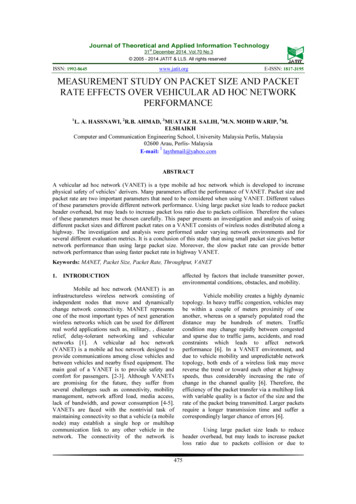
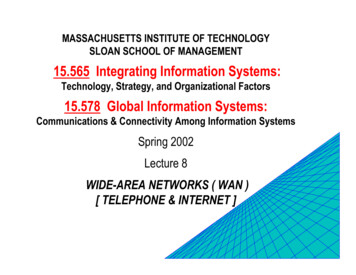
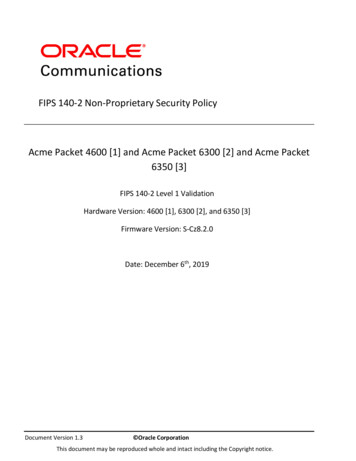





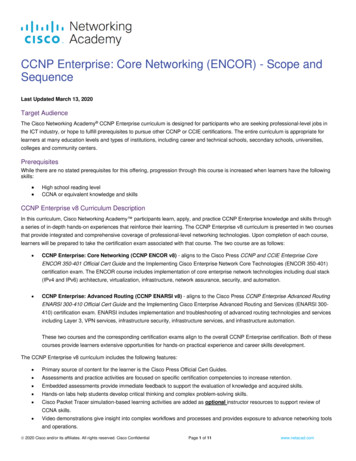

![FIPS 140-2 Non-Proprietary Security Policy Acme Packet 1100 [1] and .](/img/49/140sp3490-5601486.jpg)